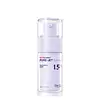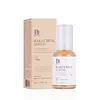What's inside
What's inside
 Key Ingredients
Key Ingredients

 Benefits
Benefits

 Concerns
Concerns

 Ingredients Side-by-side
Ingredients Side-by-side

Water
Skin ConditioningPropanediol
SolventNiacinamide
SmoothingButylene Glycol
HumectantCaprylic/Capric Triglyceride
MaskingGlycerin
HumectantPolyglyceryl-3 Distearate
EmulsifyingMethyl Trimethicone
Skin ConditioningSqualane
Emollient1,2-Hexanediol
Skin ConditioningPanthenol
Skin ConditioningGlyceryl Stearate
EmollientPolyglyceryl-6 Stearate
EmollientCetearyl Alcohol
EmollientBorago Officinalis Extract
EmollientDiphenyl Dimethicone
EmollientBakuchiol
AntimicrobialCaprylyl Glycol
EmollientTriethylhexanoin
MaskingCarbomer
Emulsion StabilisingHydroxyethyl Acrylate/Sodium Acryloyldimethyl Taurate Copolymer
Emulsion StabilisingTromethamine
BufferingTocopherol
AntioxidantAllantoin
Skin ConditioningDipotassium Glycyrrhizate
HumectantXanthan Gum
EmulsifyingGlyceryl Stearate Citrate
EmollientPolyglyceryl-10 Oleate
Skin ConditioningHydrogenated Lecithin
EmulsifyingDisodium EDTA
Adenosine
Skin ConditioningPolyglyceryl-6 Behenate
Emulsion StabilisingEthylhexylglycerin
Skin ConditioningCentella Asiatica Leaf Extract
Skin ConditioningDipropylene Glycol
HumectantFructooligosaccharides
HumectantSorbitan Isostearate
EmulsifyingPisum Sativum Extract
Skin ConditioningEel Extract
HumectantRosa Alba Leaf/Stem Extract
HumectantCetyl Ethylhexanoate
EmollientPyrus Malus Fruit Extract
Skin ConditioningFragaria Chiloensis Fruit Extract
Skin ConditioningSodium Hyaluronate Crosspolymer
HumectantHydrolyzed Collagen
EmollientSodium Ascorbyl Phosphate
AntioxidantLavandula Angustifolia Flower Extract
CleansingCeramide NP
Skin ConditioningCholesterol
EmollientLinoleic Acid
CleansingPalmitic Acid
EmollientSodium Hyaluronate
HumectantBifida Polysaccharide
HumectantMalus Domestica Fruit Cell Culture Extract
Skin ConditioningCentella Asiatica Extract
CleansingSodium Dna
Skin ConditioningWater, Propanediol, Niacinamide, Butylene Glycol, Caprylic/Capric Triglyceride, Glycerin, Polyglyceryl-3 Distearate, Methyl Trimethicone, Squalane, 1,2-Hexanediol, Panthenol, Glyceryl Stearate, Polyglyceryl-6 Stearate, Cetearyl Alcohol, Borago Officinalis Extract, Diphenyl Dimethicone, Bakuchiol, Caprylyl Glycol, Triethylhexanoin, Carbomer, Hydroxyethyl Acrylate/Sodium Acryloyldimethyl Taurate Copolymer, Tromethamine, Tocopherol, Allantoin, Dipotassium Glycyrrhizate, Xanthan Gum, Glyceryl Stearate Citrate, Polyglyceryl-10 Oleate, Hydrogenated Lecithin, Disodium EDTA, Adenosine, Polyglyceryl-6 Behenate, Ethylhexylglycerin, Centella Asiatica Leaf Extract, Dipropylene Glycol, Fructooligosaccharides, Sorbitan Isostearate, Pisum Sativum Extract, Eel Extract, Rosa Alba Leaf/Stem Extract, Cetyl Ethylhexanoate, Pyrus Malus Fruit Extract, Fragaria Chiloensis Fruit Extract, Sodium Hyaluronate Crosspolymer, Hydrolyzed Collagen, Sodium Ascorbyl Phosphate, Lavandula Angustifolia Flower Extract, Ceramide NP, Cholesterol, Linoleic Acid, Palmitic Acid, Sodium Hyaluronate, Bifida Polysaccharide, Malus Domestica Fruit Cell Culture Extract, Centella Asiatica Extract, Sodium Dna
Water
Skin ConditioningGlycerin
HumectantCaprylic/Capric Triglyceride
MaskingBakuchiol
AntimicrobialNiacinamide
Smoothing1,2-Hexanediol
Skin ConditioningCoco-Caprylate/Caprate
EmollientBehenyl Alcohol
EmollientCetearyl Olivate
Sorbitan Olivate
EmulsifyingPsoralea Corylifolia Fruit Extract
Skin ConditioningCarbomer
Emulsion StabilisingArginine
MaskingArtemisia Vulgaris Oil
PerfumingXanthan Gum
EmulsifyingCitrus Aurantium Amara Flower Extract
RefreshingEthylhexylglycerin
Skin ConditioningAllantoin
Skin ConditioningAdenosine
Skin ConditioningTocopherol
AntioxidantLavandula Angustifolia Oil
MaskingLitsea Cubeba Fruit Oil
MaskingRibes Nigrum Leaf Extract
PerfumingWater, Glycerin, Caprylic/Capric Triglyceride, Bakuchiol, Niacinamide, 1,2-Hexanediol, Coco-Caprylate/Caprate, Behenyl Alcohol, Cetearyl Olivate, Sorbitan Olivate, Psoralea Corylifolia Fruit Extract, Carbomer, Arginine, Artemisia Vulgaris Oil, Xanthan Gum, Citrus Aurantium Amara Flower Extract, Ethylhexylglycerin, Allantoin, Adenosine, Tocopherol, Lavandula Angustifolia Oil, Litsea Cubeba Fruit Oil, Ribes Nigrum Leaf Extract
 Reviews
Reviews

Ingredients Explained
These ingredients are found in both products.
Ingredients higher up in an ingredient list are typically present in a larger amount.
1,2-Hexanediol is a synthetic liquid and another multi-functional powerhouse.
It is a:
- Humectant, drawing moisture into the skin
- Emollient, helping to soften skin
- Solvent, dispersing and stabilizing formulas
- Preservative booster, enhancing the antimicrobial activity of other preservatives
Adenosine is in every living organism. It is one of four components in nucleic acids that helps store our DNA.
Adenosine has many benefits when used. These benefits include hydrating the skin, smoothing skin, and reducing wrinkles. Once applied, adenosine increases collagen production. It also helps with improving firmness and tissue repair.
Studies have found adenosine may also help with wound healing.
In skincare products, Adenosine is usually derived from yeast.
Learn more about AdenosineAllantoin is a soothing ingredient known for its protective and moisturizingg properties. Because of this, it is often added to products with strong active ingredients.
Studies show higher concentrations of this ingredient can promote wound healing.
Though it can be derived from the comfrey plant, allantoin is produced synthetically for cosmetic products to ensure purity.
Learn more about AllantoinBakuchiol is a plant-derived antioxidant (it's vegan!). It is often called the replacement for retinol although it is not part of the same family.
It has similar effects as retinol: skin smoothing, reducing discoloration, and preventing wrinkles. It does not cause as much irritation as traditional retinoids.
Bakuchiol works by breaking down free radicals and stimulating collagen production in skin.
Combining bakuchiol with retinol will not have adverse side effects. Studies show using them will just boost the benefits. Bakuchiol is also found to help stabilize retinol.
While bakuchiol does not make the skin more sun sensitive, we recommend wearing SPF on a daily basis.
Read more about traditional retinol
Learn more about BakuchiolThis ingredient is an emollient, solvent, and texture enhancer. It is considered a skin-softener by helping the skin prevent moisture loss.
It helps thicken a product's formula and makes it easier to spread by dissolving clumping compounds.
Caprylic Triglyceride is made by combining glycerin with coconut oil, forming a clear liquid.
While there is an assumption Caprylic Triglyceride can clog pores due to it being derived from coconut oil, there is no research supporting this.
Learn more about Caprylic/Capric TriglycerideCarbomer is a polymer of acrylic acid. Its main role is to create a gel consistency.
A high amount of carbomer can cause pilling or balling up of products. Don't worry, most products contain 1% or less of carbomer.
Ethylhexylglycerin (we can't pronounce this either) is commonly used as a preservative and skin softener. It is derived from glyceryl.
You might see Ethylhexylglycerin often paired with other preservatives such as phenoxyethanol. Ethylhexylglycerin has been found to increase the effectiveness of these other preservatives.
Glycerin is already naturally found in your skin. It helps moisturize and protect your skin.
A study from 2016 found glycerin to be more effective as a humectant than AHAs and hyaluronic acid.
As a humectant, it helps the skin stay hydrated by pulling moisture to your skin. The low molecular weight of glycerin allows it to pull moisture into the deeper layers of your skin.
Hydrated skin improves your skin barrier; Your skin barrier helps protect against irritants and bacteria.
Glycerin has also been found to have antimicrobial and antiviral properties. Due to these properties, glycerin is often used in wound and burn treatments.
In cosmetics, glycerin is usually derived from plants such as soybean or palm. However, it can also be sourced from animals, such as tallow or animal fat.
This ingredient is organic, colorless, odorless, and non-toxic.
Glycerin is the name for this ingredient in American English. British English uses Glycerol/Glycerine.
Learn more about GlycerinNiacinamide is a multitasking form of vitamin B3 that strengthens the skin barrier, reduces pores and dark spots, regulates oil, and improves signs of aging.
And the best part? It's gentle and well-tolerated by most skin types, including sensitive and reactive skin.
You might have heard of "niacin flush", or the reddening of skin that causes itchiness. Niacinamide has not been found to cause this.
In very rare cases, some individuals may not be able to tolerate niacinamide at all or experience an allergic reaction to it.
If you are experiencing flaking, irritation, and dryness with this ingredient, be sure to double check all your products as this ingredient can be found in all categories of skincare.
When incorporating niacinamide into your routine, look out for concentration amounts. Typically, 5% niacinamide provides benefits such as fading dark spots. However, if you have sensitive skin, it is better to begin with a smaller concentration.
When you apply niacinamide to your skin, your body converts it into nicotinamide adenine dinucleotide (NAD). NAD is an essential coenzyme that is already found in your cells as "fuel" and powers countless biological processes.
In your skin, NAD helps repair cell damage, produce new healthy cells, support collagen production, strengthen the skin barrier, and fight environmental stressors (like UV and pollution).
Our natural NAD levels start to decline with age, leading to slower skin repair, visible aging, and a weaker skin barrier. By providing your skin niacinamide, you're recharging your skin's NAD levels. This leads to stronger, healthier, and younger looking skin.
Another name for vitamin B3 is nicotinamide. This vitamin is water-soluble and our bodies don't store it. We obtain Vitamin B3 from either food or skincare. Meat, fish, wheat, yeast, and leafy greens contain vitamin B3.
The type of niacinamide used in skincare is synthetically created.
Learn more about NiacinamideTocopherol (also known as Vitamin E) is a common antioxidant used to help protect the skin from free-radicals and strengthen the skin barrier. It's also fat soluble - this means our skin is great at absorbing it.
Vitamin E also helps keep your natural skin lipids healthy. Your lipid skin barrier naturally consists of lipids, ceramides, and fatty acids. Vitamin E offers extra protection for your skin’s lipid barrier, keeping your skin healthy and nourished.
Another benefit is a bit of UV protection. Vitamin E helps reduce the damage caused by UVB rays. (It should not replace your sunscreen). Combining it with Vitamin C can decrease sunburned cells and hyperpigmentation after UV exposure.
You might have noticed Vitamin E + C often paired together. This is because it is great at stabilizing Vitamin C. Using the two together helps increase the effectiveness of both ingredients.
There are often claims that Vitamin E can reduce/prevent scarring, but these claims haven't been confirmed by scientific research.
Learn more about TocopherolWater. It's the most common cosmetic ingredient of all. You'll usually see it at the top of ingredient lists, meaning that it makes up the largest part of the product.
So why is it so popular? Water most often acts as a solvent - this means that it helps dissolve other ingredients into the formulation.
You'll also recognize water as that liquid we all need to stay alive. If you see this, drink a glass of water. Stay hydrated!
Learn more about WaterXanthan gum is used as a stabilizer and thickener within cosmetic products. It helps give products a sticky, thick feeling - preventing them from being too runny.
On the technical side of things, xanthan gum is a polysaccharide - a combination consisting of multiple sugar molecules bonded together.
Xanthan gum is a pretty common and great ingredient. It is a natural, non-toxic, non-irritating ingredient that is also commonly used in food products.
Learn more about Xanthan Gum